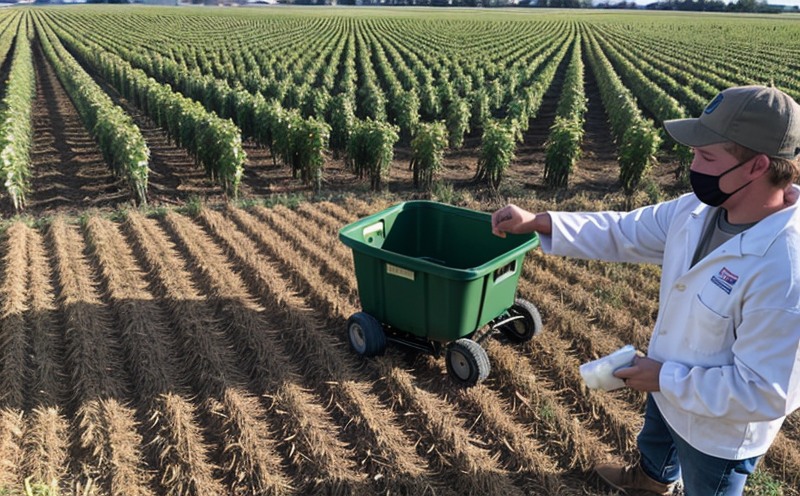Seed Viability Testing Post-Harvest
Seed viability testing post-harvest is a critical procedure in agriculture and forestry that ensures optimal planting conditions, thereby maximizing crop yield. This test assesses the percentage of seeds that are capable of germination after harvest, which is essential for determining their overall quality and fitness for use.
The process involves several steps to ensure accurate results. After harvesting, seeds undergo a series of treatments such as cleaning, drying, and grading to remove foreign materials and ensure consistent moisture content. Once prepared, these seeds are subjected to various tests that evaluate their ability to germinate under controlled conditions.
One common method is the use of the Tetrazolium Salt Test (TTC), which provides a quick visual indication of seed viability by detecting the reduction of the TTC molecule within living cells. Another technique involves placing seeds on moistened paper towels or filter papers, incubating them for several days, and observing any germination activity.
For more precise measurements, especially in research settings, advanced technologies like Respiration Analysis can be employed to measure oxygen consumption rates of the seeds. This method provides insights into the metabolic activities of dormant seeds, offering a deeper understanding of their viability status.
The importance of post-harvest seed viability testing extends beyond just ensuring immediate planting success; it also plays a pivotal role in long-term crop management strategies. By identifying seeds with compromised viability early on, farmers and researchers can make informed decisions about storage conditions, breeding programs, or even market suitability.
Understanding the factors affecting post-harvest seed viability is crucial for maintaining high standards of agricultural quality control. Environmental stressors such as temperature fluctuations, humidity levels, and exposure to pests all impact seed health. Proper handling practices during harvesting and transport can significantly mitigate these risks. Additionally, selecting appropriate storage facilities equipped with controlled environments further enhances seed longevity.
In conclusion, accurate post-harvest seed viability testing is indispensable for ensuring successful crop production cycles. It helps in making informed decisions regarding planting schedules, breeding initiatives, and overall farm management practices. Employing reliable methods ensures consistent quality across different batches of seeds, ultimately leading to healthier plants and higher yields.
Industry Applications
- Agriculture: Ensuring seed viability is paramount for successful crop production. Farmers rely on accurate tests to select high-quality seeds suitable for their specific geographic locations and environmental conditions.
- Forestry: In reforestation projects, the health of planted trees directly influences long-term sustainability. Testing seeds before planting helps avoid costly mistakes due to poor quality seeds.
- R&D: Seed scientists use viability tests to study genetic modifications or breeding programs aimed at improving crop resilience and productivity.
These applications highlight the significance of post-harvest seed viability testing across various sectors within agriculture and forestry. Accurate results contribute significantly towards sustainable practices, efficient resource utilization, and improved yields.
Why Choose This Test
Choosing seed viability testing post-harvest offers numerous advantages that cater to the diverse needs of stakeholders in agriculture and forestry. Firstly, it provides actionable insights into the quality of harvested seeds, enabling informed decision-making throughout the supply chain.
Secondly, this test supports compliance with international standards such as ISO 3632-1:2017, which specifies methods for determining seed viability using tetrazolium chloride. Compliance ensures that products meet regulatory requirements and gain market acceptance more easily.
Furthermore, accurate testing enhances trust among customers by delivering transparent information about the condition of purchased seeds. This builds long-term relationships based on reliability and quality assurance.
Lastly, seed viability testing post-harvest aids in optimizing resource utilization. By identifying substandard seeds early, unnecessary waste is minimized, and costs associated with replanting are reduced significantly.
Competitive Advantage and Market Impact
- Premium Product Offering: Providing superior quality testing services positions a laboratory as a leader in agricultural and forestry sectors, attracting premium clients seeking excellence.
- Customer Satisfaction: Accurate and reliable test results enhance customer satisfaction by ensuring they receive high-quality products that meet their expectations.
- Economic Efficiency: Early identification of problematic seeds reduces the need for costly repurchase or replacement, contributing to overall economic efficiency.
The ability to offer precise post-harvest seed viability testing also opens up opportunities for strategic partnerships and collaborations within the industry. These relationships can lead to joint R&D projects focused on developing new varieties of seeds with enhanced traits.





